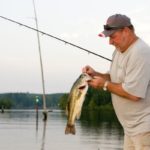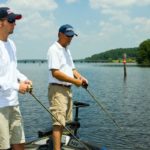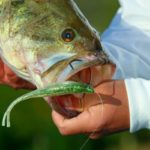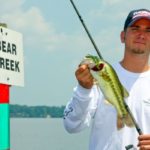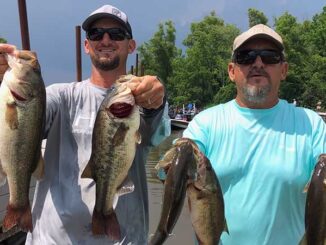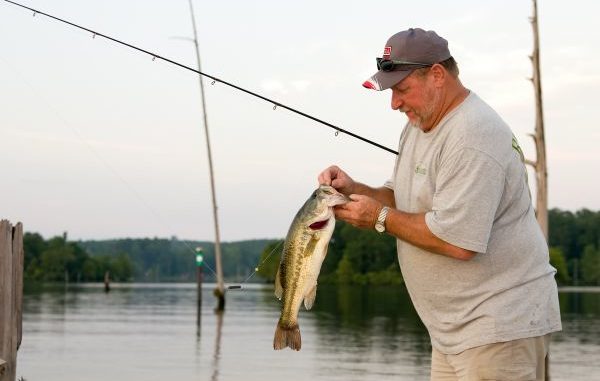
The once-glamorous Carolina rig has fallen on hard times, but anglers in the know understand that bass still can’t seem to keep from eating when a C-rig is dragged past them. Here are some tips to using the old-school setup to put more fish in the boat.
If any publicity is good publicity the Carolina rig is falling way behind. What used to be a mainstay in many tackle boxes seems to have been relegated to also-ran status.
I blame professional fishing tournaments.
Well, maybe not so much the tournaments themselves as the timing of those tournaments.
Think about it: Have you thought much about deep-diving crankbaits since they dominated the mid-1990s Bassmaster Classics?
Probably not.
When B.A.S.S. changed their end-of-the-year championship that was held during the summer to a beginning-of-the-year kickoff held during late winter, tackle trends went along for the ride.
No wonder we don’t hear much news about the Carolina rig anymore — good or bad.
Nowadays, all the media hype is about lures that appeal to bass prowling shallow flats either getting ready to spawn, actually spawning or recovering after the spawn.
Since hardly any professional tournaments are held when bass are deep — times when a Carolina rig would shine — the only attention this rig composed of a weight, a bead, a swivel, a leader, a hook and a soft plastic gets is from local anglers who have to eventually put down the shallow search baits.
So who better to turn to in an effort to find out if the Carolina rig still works than Louisiana’s local anglers who rely on their rigs to still get it done when nothing else will?
To find out if he still uses a Carolina rig, I called Zack Gagnard who operates Elite Guide Service (318-308-7574) on Toledo Bend.
“Yep, it still works,” Gagnard said with a laugh. “In fact, I’m fishing a Carolina rig right now.”
When asked why he was fishing a Carolina rig in April, Gagnard told me that the mild winter at Toledo Bend had already pushed bass into summer patterns on the main-lake river ledges.
“They’re out here on these ledges, and you’re not going to find any other way of fishing, except for a deep-diving crankbait, that is as tailor-made for fishing this deep stuff once they set up on it,” he explained.
People used to drag Carolina rigs across points and river ledges to find these little spots. The heavy weight transmitted the telltale signals of a cluster of stumps on the lip of a ledge or a rock pile at the end of a long main-lake point.
Gagnard believes fishing a Carolina rig today is the same as it’s always been; however, he admits to not using it as a search bait like he used to.
“Today, I’m all about finding deep fish on my electronics before I ever even make a cast,” he said. “The spots I’m looking for to fish a Carolina rig are really small — hardly any bigger than my boat.
“The spot on the spot, I call it. If I don’t see fish on my electronics I don’t even stop to fish the spot.”
The guide has been wearing out big bass at Toledo Bend this year on a Carolina-rigged watermelon candy or watermelon red Creme ST Craw at the end of a 4- or 5-foot leader.
If he is doing anything different with his Carolina rig, he said it might be that he is using a longer leader than most people.
“Heck, in the summer I’ll even go up to a 6-foot leader,” Gagnard said. “I basically determine my leader length by how far off the bottom the fish appear to be on my electronics.
“The longer my leader the farther up off the bottom my craw will go when I drag it.”
By fishing a longer leader, Gagnard said he’s showing bass something just a little different than all the 3-foot leaders bass are used to seeing.
But leader length isn’t the only difference in Gagnard’s Carolina-rig approach.
“When I find bass holding on a small spot, I first try to pick off the active fish with a deep-diving Strike King 10XD,” he said. “That will usually get them fired up, but it won’t last. Once they quit eating the crankbait, I turn to the Carolina rig as my mop-up bait.”
However, not content to show bass the same presentation over and over again, the angler routinely swaps casting direction and angles.
“When bass are conditioned to a bait coming one way all the time, switching up your angles makes it almost like a brand-new spot,” Gagnard said. “There’s no doubt the Carolina rig is still as good as it has always been.
“It will catch lots of fish, but if you want to catch big fish on it, it’s all about dragging it by that little sweet spot on a larger piece of structure.”
The weakest link
Like Gagnard, West Monroe’s Kenny Covington still throws a Carolina rig, even though he doesn’t like to talk much about it.
For years, Covington wrinkled his nose and furrowed his brow whenever somebody brought up the subject.
“I wanted to make people think I hated a Carolina rig and never threw it,” he said. “All the while I was making out like I would never throw one, I had one constantly tied on a rod at the bottom of my rod locker.”
Covington couldn’t help but laugh when he started talking about why so many anglers are reluctant to fish or even talk about a Carolina rig.
“It’s not a sexy way to fish,” he said. “I’ve even heard it referred to as dragging the old ball and chain.
“But if you want to consistently catch fish no matter where you are, you better keep one tied on and ready to go.”
Covington believes a Carolina rig is so effective because of bass’ curiosity about a big, heavy weight throwing up such a sediment cloud on the bottom.
And while checking out whether it’s something they might want to eat or not, along comes this worm, lizard, crawfish, what have you, and they can’t pass it up.
“Bass will go after the weakest link when they’re feeding,” Covington said. “They pick out the shad that isn’t swimming like all the rest. They eat the crawfish that isn’t as quick as the others.
“The bait at the end of a (C-rig) leader makes it look as if it’s the one that’s weakest and falling behind.”
One thing Covington said might be a little different is threading on a weight based on bottom composition.
He uses a tungsten egg weight on a slick bottom and a tungsten bullet weight on bottoms littered with wood.
“That egg weight bounces and rolls around down there like a football head jig,” he said. “They kick up a lot more sediment and make things move down there.
“I use the bullet weights in wood just because they come through the cover better without getting hung.”
One significant change Covington has made to his Carolina rig in recent years relates to the lures he uses.
Rather than centipedes, finesse worms, and lizards, Covington now uses more soft jerkbaits and soft-plastic stick baits.
“I’ve been using a Zoom Fluke on a Carolina rig for a while now,” he said. “A Fluke has become all the rage here lately on a rig, but quite a few people have been throwing them for years; they just did a good job keeping a lid on it.
“And I don’t think there’s a better lure made for a Carolina rig than a Senko.”
Covington said he believes the characteristics of a Senko that make it such an effective shallow-water lure make it just as productive at the business end of a Carolina rig.
“No matter how you pull it or how it falls, it’s always going to give you that slow shimmy when it sinks,” Covington said. “In other words, a Senko has its own built-in action, and that will pay off for you in between drags when you pause it just a second or two.”
Whether people admit to fishing a Carolina rig or not, Covington knows that at lakes like D’Arbonne in Farmerville, he’s going to be fishing behind other anglers during the summer when fish are set up on the channel holes.
In this case, the Carolina rig is a perfect technique — even though some of the other fishermen might be dragging the same rigs.
“People used to talk about spinnerbaits being like a crescent wrench because you could change them to fit so many different situations,” Covington said. “Well, a Carolina rig is just as much a fishing crescent wrench as a spinnerbait.
“You can change soft plastics, leader length, beads, line — whatever — to give bass a completely different look.”
Love-hate relationship
An admitted hater of all things Carolina rig, Simsboro’s Sid Havard knows when it’s time to throw up his hands in defeat and pull out his Carolina rig rod.
“One of the big things going with a Carolina rig right now is dragging one around the edges of the hay grass at Toledo Bend,” Havard said. “That stuff grows anywhere from 10 to 30 feet off the bank, usually in 5 to 6 feet of water. It’s not much of a summer pattern, but when bass are pulling up to spawn or moving out after the spawn, they’ll munch on a Carolina rig on the edge of that stuff.”
Unlike traditional Carolina-rigged soft plastics, though, Havard said the Zoom Fluke is growing in popularity for anglers fishing the hay grass this way.
“Something else that’s been happening with Carolina rigs lately is people using them for bed fishing during the spawn,” Havard said. “Try rigging one up with a short leader next spring and drag the weight right into the middle of the bed.
“That plastic will just kind of float around naturally in the bowl of the bed and eventually settle right into the sweet spot, where no bass will allow an intruder to be.”
As for summer fishing, Havard has noticed a trend toward 7- to 8-foot leaders, especially when fishing around hydrilla.
The theory is that a longer leader will allow a lure to ride just above the hydrilla while the weight bounces along on bottom.
But no matter how little you’ve heard about Carolina rigs lately, they’ve not gone away. Anglers are still using them to put fish in the boat even if they haven’t been talking about it.
And for those who have tried to keep it under wraps, any publicity the Carolina rig gets means more competition for bass at the lake.
While that might not be good news for them, it’s great news for the rest of us.
